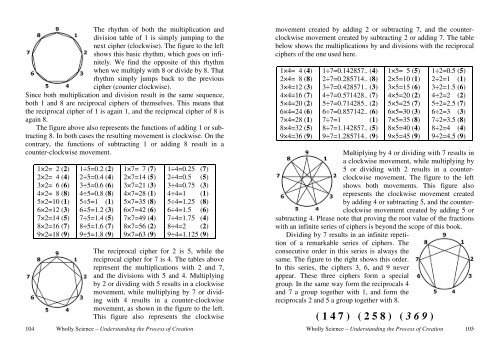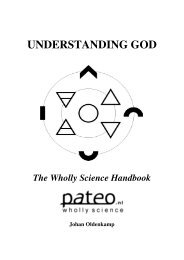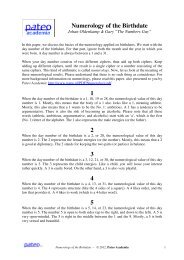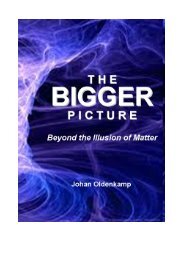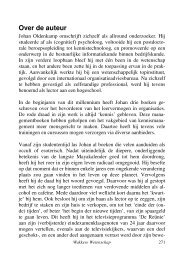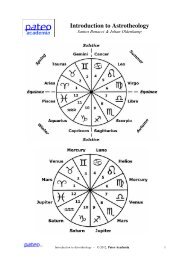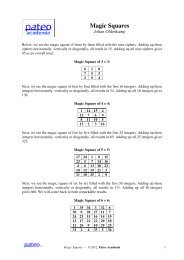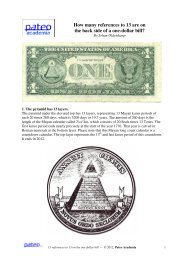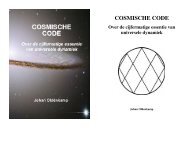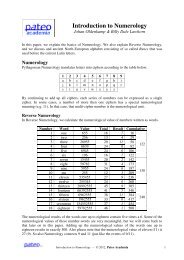WHOLLY SCIENCE - Pateo.nl
WHOLLY SCIENCE - Pateo.nl
WHOLLY SCIENCE - Pateo.nl
You also want an ePaper? Increase the reach of your titles
YUMPU automatically turns print PDFs into web optimized ePapers that Google loves.
The rhythm of both the multiplication and<br />
division table of 1 is simply jumping to the<br />
next cipher (clockwise). The figure to the left<br />
shows this basic rhythm, which goes on infinitely.<br />
We find the opposite of this rhythm<br />
when we multiply with 8 or divide by 8. That<br />
rhythm simply jumps back to the previous<br />
cipher (counter clockwise).<br />
Since both multiplication and division result in the same sequence,<br />
both 1 and 8 are reciprocal ciphers of themselves. This means that<br />
the reciprocal cipher of 1 is again 1, and the reciprocal cipher of 8 is<br />
again 8.<br />
The figure above also represents the functions of adding 1 or subtracting<br />
8. In both cases the resulting movement is clockwise. On the<br />
contrary, the functions of subtracting 1 or adding 8 result in a<br />
counter-clockwise movement.<br />
104<br />
1×2= 2 (2)<br />
2×2= 4 (4)<br />
3×2= 6 (6)<br />
4×2= 8 (8)<br />
5×2=10 (1)<br />
6×2=12 (3)<br />
7×2=14 (5)<br />
8×2=16 (7)<br />
9×2=18 (9)<br />
1÷5=0.2 (2)<br />
2÷5=0.4 (4)<br />
3÷5=0.6 (6)<br />
4÷5=0.8 (8)<br />
5÷5=1 (1)<br />
6÷5=1.2 (3)<br />
7÷5=1.4 (5)<br />
8÷5=1.6 (7)<br />
9÷5=1.8 (9)<br />
1×7= 7 (7)<br />
2×7=14 (5)<br />
3×7=21 (3)<br />
4×7=28 (1)<br />
5×7=35 (8)<br />
6×7=42 (6)<br />
7×7=49 (4)<br />
8×7=56 (2)<br />
9×7=63 (9)<br />
1÷4=0.25 (7)<br />
2÷4=0.5 (5)<br />
3÷4=0.75 (3)<br />
4÷4=1 (1)<br />
5÷4=1.25 (8)<br />
6÷4=1.5 (6)<br />
7÷4=1.75 (4)<br />
8÷4=2 (2)<br />
9÷4=1.125 (9)<br />
The reciprocal cipher for 2 is 5, while the<br />
reciprocal cipher for 7 is 4. The tables above<br />
represent the multiplications with 2 and 7,<br />
and the divisions with 5 and 4. Multiplying<br />
by 2 or dividing with 5 results in a clockwise<br />
movement, while multiplying by 7 or dividing<br />
with 4 results in a counter-clockwise<br />
movement, as shown in the figure to the left.<br />
This figure also represents the clockwise<br />
Wholly Science – Understanding the Process of Creation<br />
movement created by adding 2 or subtracting 7, and the counterclockwise<br />
movement created by subtracting 2 or adding 7. The table<br />
below shows the multiplications by and divisions with the reciprocal<br />
ciphers of the one used here.<br />
1×4= 4 (4)<br />
2×4= 8 (8)<br />
3×4=12 (3)<br />
4×4=16 (7)<br />
5×4=20 (2)<br />
6×4=24 (6)<br />
7×4=28 (1)<br />
8×4=32 (5)<br />
9×4=36 (9)<br />
1÷7=0.142857.. (4)<br />
2÷7=0.285714.. (8)<br />
3÷7=0.428571.. (3)<br />
4÷7=0.571428.. (7)<br />
5÷7=0.714285.. (2)<br />
6÷7=0.857142.. (6)<br />
7÷7=1 (1)<br />
8÷7=1.142857.. (5)<br />
9÷7=1.285714.. (9)<br />
1×5= 5 (5)<br />
2×5=10 (1)<br />
3×5=15 (6)<br />
4×5=20 (2)<br />
5×5=25 (7)<br />
6×5=30 (3)<br />
7×5=35 (8)<br />
8×5=40 (4)<br />
9×5=45 (9)<br />
1÷2=0.5 (5)<br />
2÷2=1 (1)<br />
3÷2=1.5 (6)<br />
4÷2=2 (2)<br />
5÷2=2.5 (7)<br />
6÷2=3 (3)<br />
7÷2=3.5 (8)<br />
8÷2=4 (4)<br />
9÷2=4.5 (9)<br />
Multiplying by 4 or dividing with 7 results in<br />
a clockwise movement, while multiplying by<br />
5 or dividing with 2 results in a counterclockwise<br />
movement. The figure to the left<br />
shows both movements. This figure also<br />
represents the clockwise movement created<br />
by adding 4 or subtracting 5, and the counterclockwise<br />
movement created by adding 5 or<br />
subtracting 4. Please note that proving the root value of the fractions<br />
with an infinite series of ciphers is beyond the scope of this book.<br />
Dividing by 7 results in an infinite repetition<br />
of a remarkable series of ciphers. The<br />
consecutive order in this series is always the<br />
same. The figure to the right shows this order.<br />
In this series, the ciphers 3, 6, and 9 never<br />
appear. These three ciphers form a special<br />
group. In the same way form the reciprocals 4<br />
and 7 a group together with 1, and form the<br />
reciprocals 2 and 5 a group together with 8.<br />
( 1 4 7 ) ( 2 5 8 ) ( 3 6 9 )<br />
Wholly Science – Understanding the Process of Creation 105


